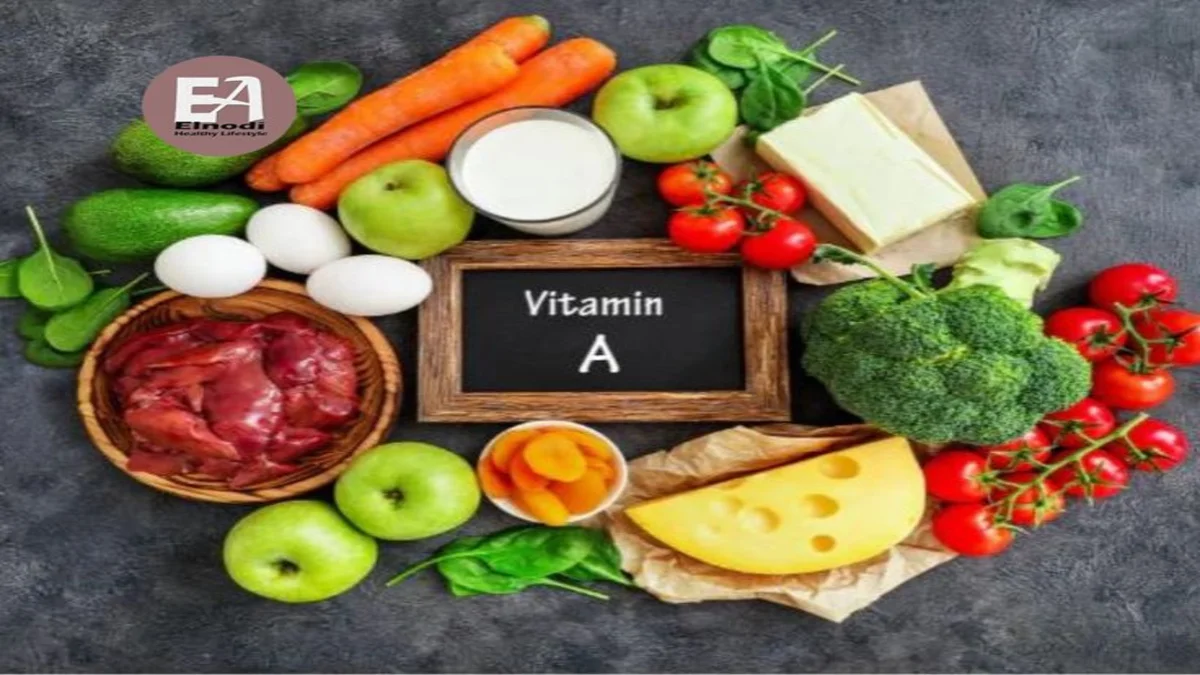The benefits of Vitamin A is a fat-soluble vitamin that is found in many foods, including fruits, vegetables, and animal products. It plays a vital role in various bodily processes and is necessary for the proper functioning of several organs and systems. While Vitamin A deficiency is rare in developed countries, ensuring you get enough of this nutrient can have numerous positive effects on your health.
What is vitamin A?
Vitamin A is an essential nutrient that helps your body develop and function properly. Vitamin A comes in two forms, each from a distinct source:
- Carotenoids (provitamin A) can be found in plant-based meals like carrots and sweet potatoes, as well as fortified diets with extra vitamins and supplements. To absorb carotenoids, your body requires good fats to turn them into the active form of vitamin A (retinol). One of the most frequent carotenoids is beta-carotene, which is responsible for plants’ orange and red hues.
- Retinoids (retinol or preformed vitamin A) are found in animal products such as eggs, fish, milk, and liver. This type of vitamin A is readily absorbed by your body.
Health Benefits of Vitamin A
Vitamin A, a fat-soluble nutrient, is essential for maintaining many elements of our health, including vision, immunological function, skin health, and reproduction. This vital vitamin is found in two forms: retinoids in animal products and carotenoids in plant-based diets. Understanding the health advantages of vitamin A highlights its importance in general well-being.
1. Vision Support
One of the most well-known effects of vitamin A is its ability to support vision. Retinol, a kind of vitamin A, is required for the production of rhodopsin, the light-sensitive pigment in the eyes. This pigment allows the eyes to adjust to variations in light, resulting in improved night vision and lowering the risk of conditions such as night blindness. Vitamin A deficiency can cause xerophthalmia, a disorder that can develop into blindness.
2. Immune System Boost
Vitamin A helps to maintain a strong immune system. It contributes to the integrity of the skin and mucous membranes, which serve as barriers against pathogens. Furthermore, vitamin A is involved in the formation and function of white blood cells, which are required for immune responses. Adequate vitamin A levels improve the body’s ability to fight infections and diseases.
3. Skin Health

The skin is the body’s biggest organ, and vitamin A is essential to its health and upkeep. Retinoids, a kind of vitamin A, are commonly used in skincare products because they enhance cell turnover and stimulate the generation of new skin cells. This not only helps to retain a youthful appearance, but it also aids in wound healing and skin disease prevention.
4. Reproductive Health
Vitamin A is essential for reproductive health in both men and women. It promotes sperm production and optimal fetal development throughout pregnancy. In females, vitamin A is required for the efficient functioning of the reproductive organs and a successful pregnancy.
5. Antioxidant Properties
Vitamin A works as an antioxidant to counteract oxidative stress in the body. This stress is created by free radicals, which are unstable chemicals that can harm cells and lead to aging and other disorders. Vitamin A protects cells from damage by neutralizing free radicals, lowering the risk of chronic illnesses including heart disease and cancer.
6. Bone Health
Vitamin A promotes bone growth and development. It works in tandem with other vitamins and minerals, like calcium and vitamin D, to keep bones strong and healthy. Vitamin A insufficiency can lead to bone problems, such as decreased bone density.
7. Cellular Communication
Vitamin A helps cells communicate and differentiate. It serves to regulate cell growth and specialization, ensuring that each cell type works properly. This is particularly important as the embryo is improving. and the formation of tissues and organs.
8. Cancer Prevention
According to certain research, vitamin A may help to reduce the incidence of some cancers. As an antioxidant, it protects cells from damage that can lead to cancer. However, it is important to highlight that the link between vitamin A and cancer is complex, and additional research is required to completely understand the mechanisms involved.
Vitamin a foods

| Food Source | Vitamin A Content (per 100g) |
|---|---|
| Animal Sources | |
| Liver (beef, pork, chicken) | 16,000 – 40,000 IU |
| Cod Liver Oil | 30,000 – 90,000 IU |
| Eggs (especially yolks) | 520 – 1,300 IU |
| Salmon | 99 IU |
| Dairy Products (milk, cheese) | Varies |
| Plant Sources (Beta-Carotene) | |
| Sweet Potatoes | 18,800 IU |
| Carrots | 8,300 IU |
| Butternut Squash | 5,600 IU |
| Spinach | 4,800 IU |
| Kale | 4,700 IU |
| Mangoes | 2,300 IU |
| Apricots (dried) | 1,300 IU |
| Broccoli | 800 IU |
| Red Peppers | 330 IU |
| Cantaloupe | 169 IU |
| Other Sources | |
| Fortified Foods (cereals, margarine) | Varies |
| Recommended Daily Intake | Varies depending on age, sex, and life stage. The Recommended Dietary Allowance (RDA) for adult males is 900 micrograms (3,000 IU), and for adult females, it’s 700 micrograms (2,333 IU). |
How much vitamin A do I need each day?
The Recommended Dietary Allowance (RDA) for vitamin A might vary depending on age, gender, and life stage. The readings are commonly expressed in micrograms (mcg) of Retinol Activity Equivalents (RAE), which accounts for the various forms of vitamin A. Here are the general RDAs for vitamin A:
| Age Group | RDA for Vitamin A (mcg RAE/day) |
|---|---|
| Infants (0-6 months) | 400 |
| Infants (7-12 months) | 500 |
| Children (1-3 years) | 300 |
| Children (4-8 years) | 400 |
| Children (9-13 years) | 600 |
| Adolescents (14-18 years) | |
| – Males | 900 |
| – Females | 700 |
| Adults (19 years and older) | |
| – Males | 900 |
| – Females | 700 |
| Pregnant Teens and Women | 750 |
| Breastfeeding Teens and Women | 1,200 |
These values are given in micrograms of Retinol Activity Equivalents (RAE) per day. It’s important to remember that a well-balanced diet with a variety of foods typically provides the necessary vitamin A, and vitamin A supplementation should be approached cautiously, especially at high doses, and under the guidance of a healthcare professional. If you have specific health concerns or conditions, it’s advisable to consult with a healthcare provider for personalized recommendations.
Side Effects Of Vitamin a
Vitamin A is a fat-soluble vitamin that is stored in the body. This means that excessive use can result in hazardous amounts.
Hypervitaminosis A is induced by taking an excessive amount of preformed vitamin A through diet or supplementation.
Symptoms may include nausea, dizziness, headaches, discomfort, or even death.
Though it can be induced by excessive dietary intake, it is uncommon when compared to overconsumption of supplements and pharmaceuticals.
Furthermore, consuming a lot of provitamin A in its plant form does not carry the same hazards because its conversion to the active form in your body is regulated.
Summary
Vitamin A is essential for many bodily activities.
It is used to promote adequate fetal growth and development, preserve good vision, and support regular organ and immune system function.
Vitamin A deficiency or excess can be harmful to your health.
The easiest method to guarantee that you have the appropriate balance is to eat vitamin-A-rich nutrition as part of your regular diet and avoid supplementing with excessive amounts.
FAQs
what is the best form of vitamin A?
What is the best way to take vitamin A?
What does vitamin A do for the eyes?
Why are vitamins good?
References
- Markell M, Siddiqi HA. Vitamins and trace elements. In: McPherson RA, Pincus MR, eds. Henry’s Clinical Diagnosis and Management by Laboratory Methods. 24th ed. Philadelphia, PA: Elsevier; 2022:chap 27.
- Mason JB, Booth SL. Vitamins, trace minerals, and other micronutrients. In: Goldman L, Schafer AI, eds. Goldman-Cecil Medicine. 26th ed. Philadelphia, PA: Elsevier; 2020:chap 205.
- National Institutes of Health website. Vitamin A and carotenoids: fact sheet for health professionals. ods.od.nih.gov/factsheets/VitaminA-HealthProfessional/. Updated June 15, 2022. Accessed February 7, 2023.
- Ross CA. Vitamin A deficiencies and excess. In: Kliegman RM, St. Geme JW, Blum NJ, Shah SS, Tasker RC, Wilson KM, eds. Nelson Textbook of Pediatrics. 21st ed. Philadelphia, PA: Elsevier; 2020:chap 61.





